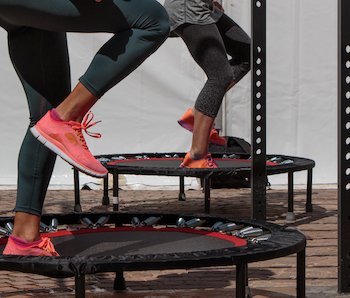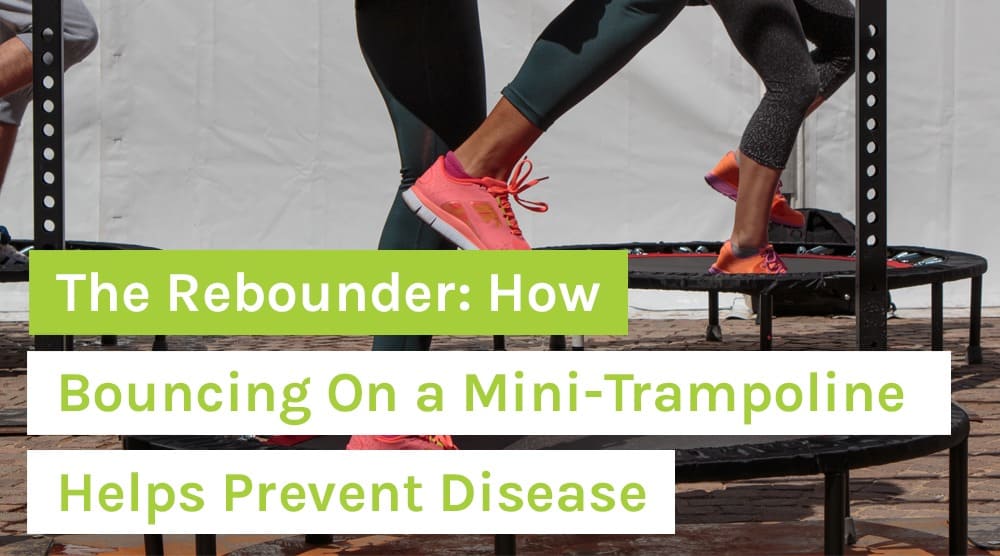The Rebounder: How Bouncing On a Mini-Trampoline Helps Prevent Disease
In a hurry? Click here to read the Article Summary...
Rebounding is a type of exercise that utilizes a small trampoline (called a “mini trampoline” or “rebounder”) for low-impact exercise. Individuals can perform a wide range of movements on a rebounder, including bouncing, twists, running in place, jumping jacks, side-to-sides, and even dance moves.
Trampolining is popular in fitness circles today, and promoters list a plethora of physical benefits from regular use. But are those claims supported with actual results?
Most natural health experts and thousands of “trampers” say YES!
Rebounding is a fun way to get your daily dose of aerobic exercise, which is extremely important to maintaining long-term health. But it seems to especially benefit the lymphatic system, reducing inflammation.
The Importance of Movement for Lowering Inflammation
The lymphatic system consists of the tonsils, bone marrow, spleen, lymph nodes, and, of course, lymph (the fluid that circulates throughout the lymphatic system).
This system has a dual function:
First, it is one of the main ways that the body eliminates toxins. It does this by circulating lymph, which carries waste and other byproducts through the nodes and out of the major detoxification pathways, especially the liver.
Second, the lymphatic system helps your body fight pathogens via the immune system, since lymph carries immune system cells. Pathogens are stored in the lymph nodes until B and T white blood cells, or lymphocytes, destroy them.
Your lymphatic system sounds like a well-oiled machine, right? Well, it is except for one caveat: unlike your blood, which has the heart and other cardiovascular mechanisms to push it through your body, the lymphatic system has no pump at all!
This is where exercise, such as rebounding, comes in. Did you know that you have three times more lymph than blood running through your body at this very moment? And the only way this fluid can keep moving is if you do.
That’s right – muscular contractions take place as you exercise, and this is the only way that lymph can circulate.
You may have heard of conditions such as lymphedema, edema, and fibrosis. According to the Lymphatic Education and Research Network (LERN) [1], there are roughly 10 million Americans who suffer from lymphedema and other lymphatic diseases.
These painful and sometimes debilitating conditions are all different manifestations of the same thing: lymph that is not flowing properly through the body. Stagnant lymph inevitably leads to inflammation, which is the foundation of almost all disease.
The Health Benefits of Using a Rebounder Trampoline
 Some people suffer from genetic lymphatic deficiency conditions, while others are prone to lymphedema because of lymph node removal; up to 50% of those who get Auxiliary Lymph Node Dissection may develop lymphedema, according to National Cancer Institute statistics [2].
Some people suffer from genetic lymphatic deficiency conditions, while others are prone to lymphedema because of lymph node removal; up to 50% of those who get Auxiliary Lymph Node Dissection may develop lymphedema, according to National Cancer Institute statistics [2].
The vast majority of lymphatic conditions, however, could be prevented by simply moving the body more and making other lifestyle changes. Especially for those who have had several lymph nodes removed, regular exercise can significantly reduce symptoms.
The most renowned study showing the health benefits of rebounding was a 1980 investigation conducted by NASA and the University of Kentucky [3]. The purpose was to determine the best kinds of exercise for astronauts, who inevitably lose muscle mass while in space.
In the study, healthy male athletes ages 19-26 were instructed to run on a treadmill with intervals of rest in between. Pulse, oxygen consumption, and other factors were measured. A week later, the athletes returned to be tested using the same parameters on a trampoline.
Here are some of the discoveries researchers made:
The “magnitude of the bio-mechanical stimuli” is higher using a mini-trampoline than a treadmill. This finding led researchers to postulate that rebounding may help in determining “remedial procedures” for returning astronauts.
“The external work output at equivalent levels of oxygen uptake were significantly greater while trampolining than running” and that the “greatest difference was about 68%.” This is significant because it indicates that using a trampoline as opposed to a treadmill can give a person a solid aerobic workout and corresponding healing effects with less effort (i.e. oxygen used and demand on the heart).
Additionally, NASA researchers noted that the “biomechanical conditioning” (benefits of the workout on the body) may be twice as efficient with trampolining than running.
The study recognized how extremely low-impact rebounding is. Putting less pressure on the muscles and joints, especially the ankles, knees, and hips, allows a person to exercise at longer intervals without feeling fatigued.
A study published in 2014 found that 12 weeks of exercise with a mini-trampoline “significantly” helped elderly women with their balance [4].
Others speculate that a mini-trampoline may be particularly beneficial for those who have knee and other joint issues, including arthritis. The smaller diameter prevents how high you can jump, and also reduces the gravitational pull on your knees, reducing impact [5].
“Rebounding allows the muscles to go through the full range of motion at equal force. It helps people learn to shift their weight properly and to be aware of body positions and balance,” said Dr. James White, PhD, director of research at the physical education department at the University of California at San Diego, in an interview with Vitality Magazine [6].
In that same article, Vitality Magazine explains how rebounding can significantly help with symptoms of lymphedema through “muscle contraction, force of gravity, and internal massage,” all of which can encourage lymphatic flow.
Can Rebounding Even Help to Prevent Cancer?
Getting your lymphatic system going again through rebounding doesn’t only prevent painful symptoms in the extremities. Rebounding, along with proper hydration and a healthy lifestyle, helps to lower the risk of disease in general with its lymph-boosting, inflammation lowering, blood-cleansing, and detoxification-aiding attributes.
Besides harboring T and B lymphocytes, the lymph nodes are also a production place for Natural Killer cells [7], which specifically target cancer cells for destruction.
3 Types of Rebounder Workouts
 Natural healing advocate Chris Wark of Chris Beats Cancer personally used rebounding as one of his main protocols for naturally healing from colon cancer [8]. He explains three main modes of rebounder trampoline exercise:
Natural healing advocate Chris Wark of Chris Beats Cancer personally used rebounding as one of his main protocols for naturally healing from colon cancer [8]. He explains three main modes of rebounder trampoline exercise:
#1: The Health Bounce:
Lightly bounce up and down on the rebounder while leaving your feet on the mat. This is designed for those who may not be able to do more aerobic tramping, and can be done several times a day from 10 minutes up to an hour.
#2: The Strength Bounce:
This bound has one step: simply bounce as high as you safely can! It is built for strengthening muscles, improving balance, and moving lymphatic fluid.
#3: Aerobic Bounce:
You can dance, jump, twist, run, or invent your own move. Just keep up the intensity until you get your blood pumping and start to sweat.
Where Can You Rebound?
You can rebound at the gym, but most individuals purchase a mini-trampoline to use at home and/or a collapsible travel rebounder to take on the road.
Mini-trampolines are fairly inexpensive, but spending a bit more to get a premium rebounder trampoline may be worthwhile. Just be sure that your mini-tramp has enough spring to prevent jarring of the knees and other joints.
The popularity of rebounding signifies a greater understanding of the importance of the lymphatic system for overall health, boosting the immune system, lowering inflammation, and creating detoxification, energy, and vitality in the body.
It is safe to say that rebounding could rank among the top exercises for overall disease prevention. It’s official: trampolines are not just for kids anymore!
Turmeric 3D from Organixx provides you one of the most “bioavailable” forms of turmeric due to its unique fermentation process. This means your body experiences the maximum benefits of the purest, most potent turmeric available!

 Sources:
Sources:
Article Summary
Rebounding is a form of exercise using a mini trampoline, and is becoming a popular fitness practice.
Rebounding is a fun way to get your daily dose of aerobic exercise, and it is especially beneficial to the lymphatic system.
Muscular contractions take place as you exercise, and this is the only way that lymph can circulate.
Stagnant lymph inevitably leads to inflammation, which is the foundation of almost all disease.
The vast majority of lymphatic conditions could be prevented by simply moving the body more.
Rebounding can be more efficient than traditional cardio, and is much easier on the joints.
Rebounding could rank among the top exercises for overall disease prevention.




Is it good for bone building for osteoporosis . It seems like more stress on the ground would be better
the stress put on the joints from rebounding is adequate, while the risk of the impact from ground jumping outweighs whatever benefits may be had from it, particularly on the 3rd age..
The best article ever!!! Thanks for bringing this back to the front burner!
Suggestion for how long each day?
Would jumping up and down without the trampoline be as beneficial as using a trampoline?
Do you recommend a particular brand of rebounder?